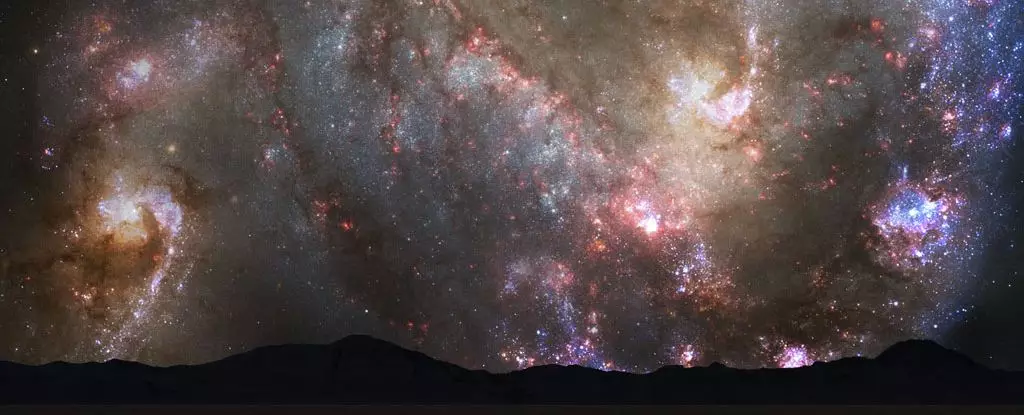The grandiosity of the cosmos elicits wonder and contemplation. Recent investigations led by astrophysicist Till Sawala from the University of Helsinki have cast a fascinating light on the long-predicted collision between our Milky Way galaxy and its neighbor, Andromeda. Contrary to alarmist claims that our galactic demise is imminent, the team’s analysis suggests that the fate of the Milky Way is far from sealed, bringing forth a cosmic duality. The likelihood of a collision over the next 10 billion years is a coin flip—there’s around a 50% chance that these galaxies will engage in a dramatic union, yet there remains an equal chance that they will simply drift past each other, akin to silent ships in the vastness of space.
This revelation illuminates how nuances in scientific modeling can unearth alternatives to seemingly settled conclusions. Sawala emphasizes that the essence of their findings does not contradict previous work but rather adds layers of complexity to it. The Milky Way-Andromeda collision, often referred to as “Milkomeda,” has been deemed a near certainty for eons, yet the prospect of these celestial bodies coexisting peacefully presents a paradigm shift in our understanding of the Local Group of galaxies, a cosmic family that includes the Milky Way, Andromeda, Triangulum, and the Large Magellanic Cloud.
Understanding the Local Group: Beyond the Giants
To grasp the dynamics at play within our cosmic neighborhood, it’s crucial to recognize that the Milky Way and Andromeda are not solitary actors. Their gravitational ballet is influenced by the gravitational pulls of their smaller companions in the Local Group. The new simulations employed by Sawala and his team utilized the latest observations from the Hubble and Gaia space telescopes, augmenting their data pool with precise mass estimates for the four most significant galaxies within this group. Examining how different configurations of these galaxies might alter future outcomes adds complexity and presents a clearer picture of the cosmic dance unfolding.
Sawala’s team found that including the Triangulum galaxy significantly raised the chances of a merger—showing the intricate ballet of gravitational forces and how they interact over astronomical timescales. When the Milky Way and Andromeda were modeled alone, they showed a merger in just under half of the simulations; however, incorporating the Triangulum raised the odds to two out of three. Conversely, substituting in the Large Magellanic Cloud instead can dilute those chances down to one in three. This academic endeavor highlights how seemingly insignificant partners can dramatically skew probabilities in the grand ensemble of the cosmos.
Futuristic Forecasts: The Challenge of Predictive Astronomy
The ambitious scale of predicting cosmic events over such extensive timescales raises pivotal questions about the complexities at play. The inherent unpredictability of events further into the future is a significant aspect of astrophysics that challenges our intuitions. The extrapolation of dynamic interactions between galaxies is as intricate as the fabric of space-time itself. Sawala underscores that while we can venture predictions, the limitless nature of cosmic phenomena necessitates caution against overconfidence.
Indeed, models will likely need refinement as we procure more advanced observational tools. Every investigation unveils new surprises and reveals previously unseen factors that may influence galactic trajectories. The uncertainty about the galaxies’ eventual paths resonates with an understanding that our knowledge is constantly evolving. The gravitational chaos between these stellar giants can lead to vastly different cosmic outcomes, from merger to mere near encounters, suggesting that our comprehension of galactic dynamics is still in its infancy.
A Call for Curiosity: The Future of Cosmic Relationships
Underneath the layers of uncertainty is an invitation to view our position in the universe with humility. The work produced by Sawala’s team isn’t the final word but sets the stage for a deeper inquiry into cosmic relationships. The multiplicity of interactions causes a dynamic environment where even modest changes to a system’s parameters can lead to profoundly different results. Such insight should spark further curiosity in both the academic community and the general public, propelling us to question the unknowns and explore the complexities of our cosmic surroundings.
Ultimately, the potential for significant changes to our understanding of galaxy evolution lays the groundwork for exciting discoveries ahead. The questions raised by the new studies open avenues for richer discussions about not only our galaxy’s fate but also our broader understanding of the universe. The dance of the galaxies is far from over, and perhaps the best is yet to come.

